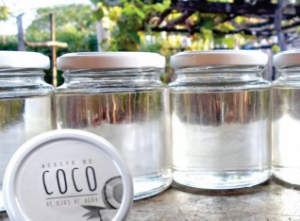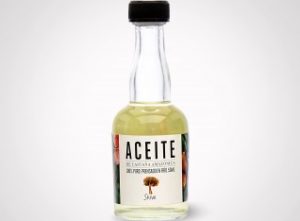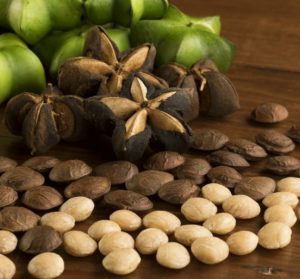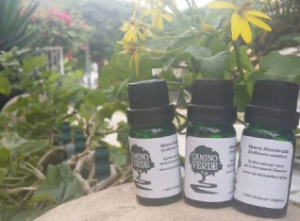A few days ago, my sister noticed that I had gained a little weight. She looked at me from left to right and from right to left. After a cordial pause she suggested I consider reducing the amount of oil I use to cook, or to explore alternative oils around me. “Take advantage of the fact that you work for Canopy Bridge”, she said before I could blame Christmas or News Year’s. I should admit it: I have never found a reason to give much thought to oils. In general, they´ve seemed fairly simple and straightforward to me: oil was just cooking oil. The complexities behind their extraction eluded me. But I was wrong.
In Canopy Bridge you’ll find the sorts of oils that will get you to appreciate oils if you don’t already. I didn’t, and here we are now. Some of these oils can be used to cook, others have pharmaceutical and cosmetic purposes. The list we curated is, specifically, a selection of Amazonian oil producers with great potential. While the first three are cooking oils, extracted from fruits or nuts, the other two are essential oils, distilled from different parts of the plant.
1. “Asociación Ojos de Agua” Coconut Oil

The coconut oil produced by Association of farmers in Ojos de Agua Conservation Concession is made from the flesh of grated coconuts from the Picota province, in the Peruvian Amazon. The oil has gotten good press as an alternative to other oils because even though it has high levels of saturated fats, the type of fat found in coconut is not the same as the sort you find in red meats, for instance. Not all fats are bad. Medium chain triglycerides –which is what you find in these oils– may boost HDL (“good”) cholesterol and in moderation can be part of healthy diet. Though be careful, as always, of claims of miracle foods – there´s no reason to believe that coconut oil will actually help you lose weight, as some claim. While in the kitchen coconut oil can be used to cook and bake, it also contains proteins that help with hair care, often as a conditioner.
But the most important thing about Ojos de Agua Coconut Oil is the way it’s produced. In 2003, farmers from the District of Pucacaca in the province of Picota, Peru, organized to form in 2007, an association that would allow them to administer their own territory. Since 2010, men and women members have identified the natural processing of coconut as a viable alternative to finance their conservation efforts. Coconut grows abundantly in the region but continues to be undervalued. Commercializing with coconut oil has become a way to generate additional income with minimal impact. Nothing goes to waste: coconut peels are later used to make carbon blocks, which can be used as fuel.
If you want to know more about Ojos de Agua oil, check out their Canopy Bridge profile.
2. Shiwi

Shiwi has so much! Honey, chilies, beer, oils. Their most unique product, though, is their virgin Brazil nut oil. The Brazil nut can be eaten raw –hard and crunchy– toasted or can be turned into flour for baked goods. Containing fibre, all kinds of vitamins and many, many minerals, it has great nutritional value. Shiwi suggests using the oil for cooking, as salad dressing or on bread as a spread.
The Brazil nut (Bertholletia excelsa) comes from one of the largest trees of the Amazon, but it’s far more valuable for its delicious and wild-harvested seed is than for its timber. Building a market around it allows forest communities to earn income without succumbing to the temptation of more destructive, non-renewable practices.
Shiwi was created in 2011 by Sofia Rubio, a biologists and environmentalist. The nuts come from Madre de Dios province, in the Peruvian Amazon, in collaboration with producers from Tambopata Reserve. Because I know you now really want to get some Brazil nut oil, here is Shiwi’s profile.
3. Candela Peru

Candela Peru creates value in high-risk, fragile areas by processing and selling natural products. For me, they have one big star: Sacha Inchi oil. And I mean “star” literally. The seed of Sacha Inchi, a climbing plant, looks like a star turned into a nut. It was big in the Inkan Empire before the arrival of the Conquistadors and is represented in archeological artifacts from the time. Sacha Inchi, the star, is very nutritional as well, with antioxidants, vitamins and lots of protein. Their products have over six certification. To learn more click here.
4. Chankuap essential oils
I had never given a second thought to the difference between essential oils and, well, other kinds of oils. So, to me, this was important: essential oils are distilled from the leaves and roots of the plant. They are concentrated substances, so their fragrance is much stronger. They are mostly used for aromatherapy, to apply on the skin or to pour drop by drop on some beverages or dishes for flavor.
Chankuap has a great variety of oils. But their ginger oil, recommended for sore throat, was particularly attractive. I live in a cold city, so the idea of pouring a few drops of ginger oil in hot water with lemon to drink while it rains outside –is cliche, I know– but wonderfully appealing. It can also be applied for muscle pains and for massages. Their catalog includes organic ishpink, organic curcuma, lemon verbena, cultivated in Achuar and Shuar traditional gardens.
The Chankuap Foundation was founded in 1996 through the work of the Wasakentsa Salesian Mission, in Achuar territory in the province of Macas in the Ecuadorian Amazon. It is a project designed to promote sustainable and community-driven work in the area. The producers at Chankuap Foundation come mostly from Shuar and Achuar territories, which face pressures from expanding pasture land despite having traditionally been hunting territory. The Achuar people –whose name means “people of the spring palm”–live in southern tip of the Ecuadorian Amazon close to Shuars –”people of the mountain”– who dwell at the foot of the Eastern Andes.
The Chankuap Foundation sells their products in person from the city of Macas. But, for sales involving longer distances visit their Canopy Bridge profile.
5. Camino Verde Essential Oils

Camino Verde Tambopata has enormous potential. Their objective is to protect the biodiversity of the Peruvian Amazon through the strategic and sustainable use of the natural resources at the riverbanks of the Tambopata River. How? By doing creating an alternative economy that can compete and overcome the timber-industry. In essence (like their oils!), Camino Verde is a reforestation initiative.
But the most interesting part of the work they do is the creativity it involves. Against the pressures from the timber industry, Camino Verde is creating a unique line of essential oils made out of weird, unknown species. One example is their oil of Moena alcanforada, from a tree in the same family as threatened Brazilian rosewood. Camino Verde is the only producer in the world of this camphrous, anti-inflammatory essential oil. In that sense, theirs is an exploration and a creation.
The stakes for Camino Verde Tambopata are high, so the quality of their product is paramount. To know more about what they offer, here is their Canopy Bridge profile.


